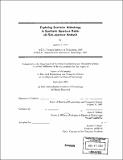| dc.contributor.advisor | Alan S. Willsky. | en_US |
| dc.contributor.author | Kim, Andrew J | en_US |
| dc.contributor.other | Massachusetts Institute of Technology. Dept. of Electrical Engineering and Computer Science. | en_US |
| dc.date.accessioned | 2005-08-23T22:27:03Z | |
| dc.date.available | 2005-08-23T22:27:03Z | |
| dc.date.copyright | 2001 | en_US |
| dc.date.issued | 2001 | en_US |
| dc.identifier.uri | http://hdl.handle.net/1721.1/8698 | |
| dc.description | Thesis (Ph. D.)--Massachusetts Institute of Technology, Dept. of Electrical Engineering and Computer Science, 2001. | en_US |
| dc.description | Includes bibliographical references (p. 189-193). | en_US |
| dc.description.abstract | Scattering from man-made objects in SAR imagery exhibits aspect and frequency dependencies which are not always well modeled by standard SAR imaging techniques based on the ideal point scattering model. This is particularly the case for highresolution wide-band and wide-aperture data where model deviations are even more pronounced. If ignored, these deviations will reduce recognition performance due to the model mismatch, but when appropriately accounted for, these deviations from the ideal point scattering model can be exploited as attributes to better distinguish scatterers and their respective targets. With this in mind, this thesis develops an efficient modeling framework based on a sub-aperture pyramid to utilize scatterer anisotropy for the purpose of target classification. Two approaches are presented to exploit scatterer anisotropy using the sub-aperture pyramid. The first is a nonparametric classifier that learns the azimuthal dependencies within an image and makes a classification decision based on the learned dependencies. The second approach is a parametric attribution of the observed anisotropy characterizing the azimuthal location and concentration of the scattering response. Working from the sub-aperture scattering model, we develop a hypothesis test to characterize anisotropy. We start with an isolated scatterer model which produces a test with an intuitive interpretation. We then address the problem of robustness to interfering scatterers by extending the model to account for neighboring scatterers which corrupt the anisotropy attribution. | en_US |
| dc.description.abstract | (cont.) The development of the anisotropy attribution culminates with an iterative attribution approach that identifies and compensates for neighboring scatterers. In the course of the development of the anisotropy attribution, we also study the relationship between scatterer phenomenology and our anisotropy attribution. This analysis reveals the information provided by the anisotropy attribution for two common sources of anisotropy. Furthermore, the analysis explicitly demonstrates the benefit of using wide-aperture data to produce more stable and more descriptive characterizations of scatterer anisotropy. | en_US |
| dc.description.statementofresponsibility | y Andrew J. Kim. | en_US |
| dc.format.extent | 193 p. | en_US |
| dc.format.extent | 19035456 bytes | |
| dc.format.extent | 19035213 bytes | |
| dc.format.mimetype | application/pdf | |
| dc.format.mimetype | application/pdf | |
| dc.language.iso | eng | en_US |
| dc.publisher | Massachusetts Institute of Technology | en_US |
| dc.rights | M.I.T. theses are protected by copyright. They may be viewed from this source for any purpose, but reproduction or distribution in any format is prohibited without written permission. See provided URL for inquiries about permission. | en_US |
| dc.rights.uri | http://dspace.mit.edu/handle/1721.1/7582 | |
| dc.subject | Electrical Engineering and Computer Science. | en_US |
| dc.title | Exploring scatterer anisotrophy in synthetic aperture radar via sub-aperture analysis | en_US |
| dc.type | Thesis | en_US |
| dc.description.degree | Ph.D. | en_US |
| dc.contributor.department | Massachusetts Institute of Technology. Department of Electrical Engineering and Computer Science | |
| dc.identifier.oclc | 49839249 | en_US |
